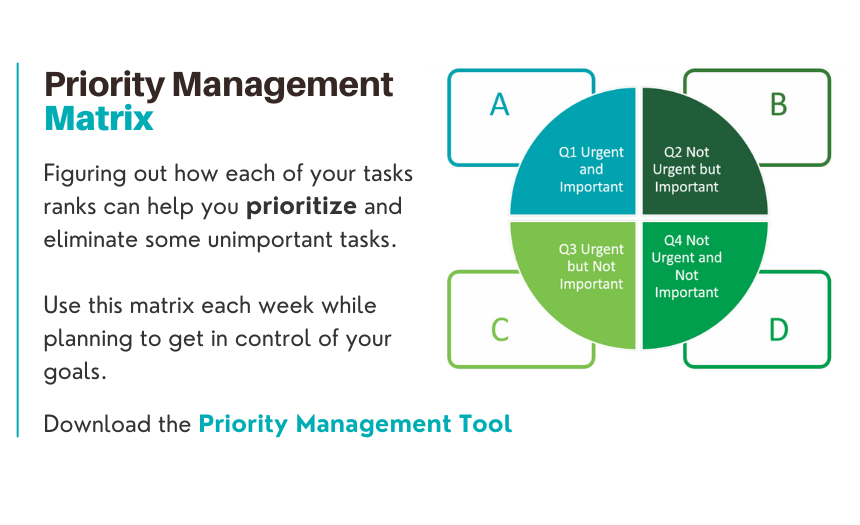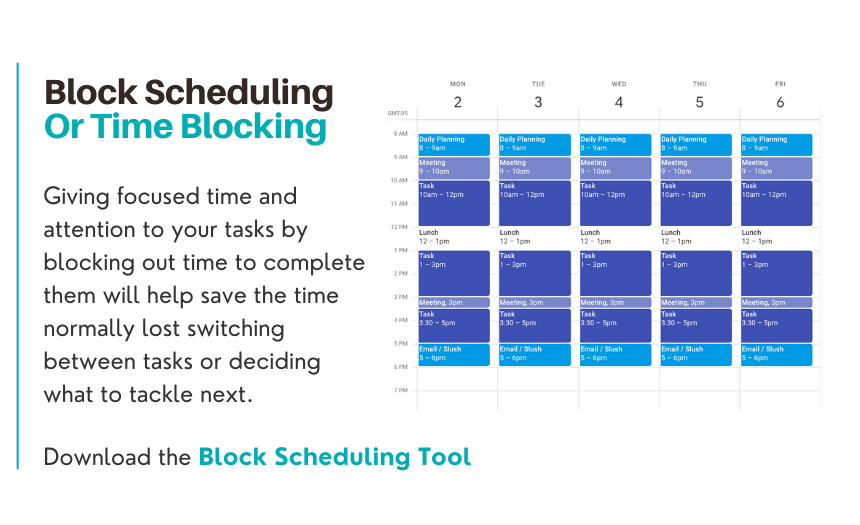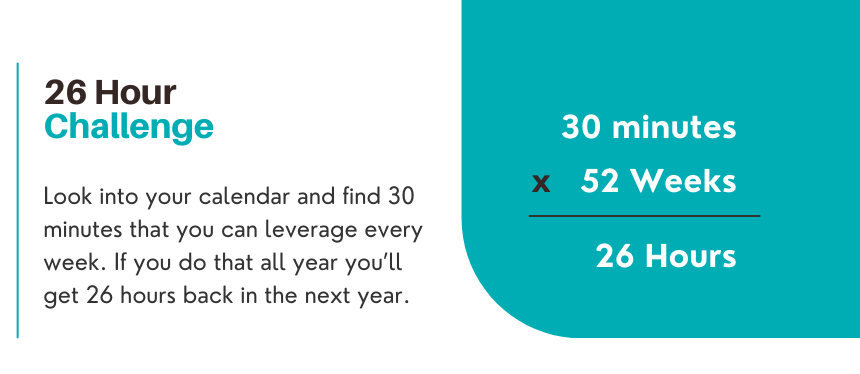Move the needle in your business by learning to prioritize tasks and manage your schedule to hit all of your goals.
When running a small business, productivity is key to success. Productivity is deeply connected to profit and impacts long-term performance and goals for the entire company.
With a limited number of employees, small businesses are particularly susceptible to the negative effects of low productivity. Inefficiency in the workplace can lead to project delays, missed deadlines, low morale, and poor engagement, directly impacting your profitability and preventing future growth.
For these reasons and more, it’s vital to adopt strategies that allow you to boost your efficiency to accomplish more with less. Make sure to leverage the power of tailored performance improvement advsing to boost the performance of your business even more.
The Cost of InefficiencyProductivity is a way to measure efficiency. Often, people think of productivity as simply getting more done in less time. But, to be successful in business, it’s not just about getting more done; it’s about getting the right things done. |
Time Management Vs Priority Management
Productivity can be broken down into two main buckets: time management and priority management.
Time management is the process of organizing and planning how to divide your time between specific activities. Developing effective time management habits enables you to work efficiently to get more done in less time. On the other hand, priority management focuses on time and resources towards tasks that impact high-value projects and long-term goals. Thus, prioritizing enables you to get more quality work done and reduce the amount of time spent on unnecessary tasks.
Being in control of your time directly correlates to being in control of your goals. And the more you focus on the right tasks, the more impact you will see in your business.
In working with hundreds of entrepreneurs, we’ve found that together, time and priority management can make a significant impact on your business. Consider this; if you could save one extra hour a day, you would save 240 hours or six weeks over the year. Imagine the shift you can create with an additional six weeks of free time to work on high-impact items.
Luckily, making small changes in your habits can drastically improve your productivity and efficiency to improve output and ensure you hit your goals. We’ve pulled our resources together to create a guide that you can use to improve your time and priority management skills. In this post, we will discuss how to plan, prioritize your tasks in alignment with your goals, and structure your schedule to ensure you stay efficient and reduce burnout. We’ll also share a few key takeaways, including:
- A simple process to help you prioritize your tasks each week in alignment with your entrepreneurial vision
- An easy to use tool to aid in creating a work schedule that groups tasks together to help you accomplish more
- Tactics for how to leverage time and delegate tasks to your team
- Tips for how to manage your energy throughout the day/week to avoid burnout
With these resources, you’ll be able to develop new habits that will help you maximize your productivity.
Align your Goals With Your Vision
Increasing your productivity isn’t rocket science; it just requires being more intentional about prioritizing and managing your time. To ensure you prioritize the right tasks, you need to take a step back and remember what you are working toward.
Where do you see yourself in one year? Three years? Five years? Envisioning your future allows you to place markers and plot out your journey. For your business, you should be working to achieve your company’s long-term vision.
A clear vision acts as a guiding force behind all aspects of your business and will help you make better decisions. Setting a clear focus helps to align your goals and ultimately helps position your company on the path to sustainability and profitability.
With your vision, you can start to outline your goals for the next year to know what objectives you must hit each month to be on track for your business’s long-term success.
Plan Ahead
One of the biggest keys to success is giving yourself time and space to plan. Setting aside time to prepare for the upcoming week will help you generate a proactive mindset and provide you with the direction and guidance needed to stay focused on the right tasks.
To ensure you start on the right foot with planning, you need to learn to prioritize. Below, we’ll outline an easy way to break down your tasks and provide a tool to help make the process easier.
Prioritize Your Tasks
As mentioned above, it’s not just about getting more done; it’s about getting the right things done. When running a business, your “to-do” list never ends. And unless you prioritize your tasks, everything feels important in the moment.
We all have the same number of hours in a week, and even if you work overtime, there will be times when you can’t accomplish everything. A good rule of thumb is to prioritize your tasks each week. By evaluating your tasks, you’ll have a clear idea of what you need to accomplished versus what can be moved or delegated to someone else.
On your own, prioritizing your tasks can be difficult; again, everything feels important. With our Priority Management tool, you can get in control of your to-do list by ensuring your tasks align with your year-end goals.
 |
Once a week, do a brain dump. Write down everything you need to accomplish this week, keeping in mind the big rock items you must complete this quarter or this month to hit your year-end goals(the vision).
Then, take a look at your tasks through the lens of achieving your goals, and start ranking those tasks by priority.
At Cultivate, we rank tasks by two key factors: Urgency and Importance. Urgency is how fast a task needs to be completed, and Importance is how much impact the task has on the end goal. Using this scale, tasks can fall into four buckets: Urgent & Important, Not Urgent but Important, Urgent but Not Important, or Not Urgent & Not Important. Figuring out how each of your tasks ranks can help you prioritize and eliminate some of those unimportant tasks.
To do this, assign a letter to everything on your list:
- A – Urgent & Important (do first)
- B – Not Urgent but Important (do later)
- C – Urgent but Not Important (delegate)
- D – Not Urgent & Not Important (eliminate)
Once you evaluate your tasks, you’ll have a crystal clear idea of what will help you accomplish your goals and where you should focus your energy.
Map Out a Schedule
Planning and prioritizing your tasks will only get you so far. Besides knowing what you need to work on, you need to know when you will work on it.
Without a structure for your schedule, even your highest priority projects don’t have consistent room for execution. It’s a slippery slope to falling behind and missing your goals. A simple trick is to use block scheduling (sometimes known as a time block schedule) to group similar tasks into one batch throughout the week. For example, instead of reaching out to prospects sporadically throughout the week, schedule a 2-hour block twice a week to focus on business development.
By grouping similar tasks together, you can develop a groove and work faster and more efficiently. We recommend using a time blocking approach called Block Scheduling.
Setting your blocks is simple: Identity common tasks such as business development or emails and estimate how much time those items will take to complete. Then plug it into your calendar, just like you would a meeting or event.
 |
With our Block Scheduling tool, you can categorize your tasks, schedule the time needed to complete each task create a roadmap for your week.
The tricky part is finding a groove that works for you. Understand how you work so you can schedule tasks based on when you will be most productive. You will also need to be mindful of deadlines. Keep your priority list in mind when carving out your blocks and schedule time-sensitive items early on in the week.
Once you’ve set a schedule, you can track how long each batch of tasks took to complete. Did you stay on track? Do you need more or less time to complete your tasks? Once you’ve got a good understanding of your working habits, use that to keep yourself accountable and productive.

Contact Cultivate Advisors for advice on how to optimize workflow, boost productivity and improve profitability! And you’ll focus on what's really important - growing your company!
Team Effectiveness ConsultingCreate a Buffer
Regardless of how well you plan, things will come up during the week that needs your attention. It’s important to stay agile and handle new challenges as they arise. However, this does mean you should throw out your week’s plan when something comes up. A good rule of thumb is to plan extra time in your calendar for things to go awry. This extra time slot is just a little bit of cushion throughout the day for an emergency or anything time-sensitive.
Depending on your job, you may need more slush time than others; for example, if you work in real estate, you may have to plan more time for calls and various interruptions than someone with a more predictable routine.
Consider starting with an hour of extra time every day. If you need it, great; if not, you now have time to pull another project forward.
Multiply Your Time with Delegation & Leverage
We all have the same 168 hours in a week, so why do some people seem to get more done?
It’s easy to assume that the most productive people just work harder, but that’s not necessarily true. The key is to work smarter, not harder. And sometimes working smarter meaning asking for a little help.
You can’t complete every task on your own. Don’t be afraid to delegate simple tasks to your team members or hire a virtual assistant to help with basic tasks. Your time as an entrepreneur is valuable; don’t waste your time on activities that would be better handled by someone else.
Leverage and delegation are the keys to multiplying your time but used incorrectly; you could wind up wasting countless hours.
Leverage
You can only do so much on your own; getting better at time leverage will allow you to expand greatly past your current capacity without being overworked. Leverage is achieving the biggest result with the least amount of effort.
We only have so many hours in a day, and if you can leverage your time, other people’s time, and time-saving through technology, you can get more done in less time.
As you plot out your week, look for opportunities to save time. Here are a few examples of ways you can save time every week.
- Use block scheduling. As mentioned above, block scheduling allows you to work on similar tasks in blocks to increase your efficiency.
- Take advantage of your commute. Leverage time on your commute by scheduling calls to be completed during that time.
- Use meetings to address multiple topics. If you are meeting with someone, use that time to cover additional topics that you intended to talk to them about. This will help you save time by eliminating the need to schedule another meeting or going back and forth over email.
- Utilize technology. There are several apps or software you can use to save time. For example, you can use a calendar app that sends reminders for upcoming events to eliminate the time needed for follow-up. Or you can use project management software to keep track of where your team is on a project.
- Create Procedures. Establish a procedure for recurring tasks, preferably in writing. Established procedures reduce errors and help speed up the process.
- Delegate. Nothing is more efficient than having someone else complete an entire task for you, provided they will do it effectively.
The Value of LeverageTo understand the value of leverage, look at your current schedule, and find one 30 minute task you could leverage. If you could save half an hour a week through leverage, you’ll gain an extra 26 hours a year. That’s time you can put towards a new project or goal.
|
Delegation
Delegation is the art of asking for help. By empowering others to help you in pursuit of your goals, you will realize the greatest return on leverage.
If you delegate, you need to ensure the receiver of the task is set up for success. There is a common disconnect between delegation and success. Don’t just hand things off without training and follow up.
While delegating can be important and save you time and productivity, it’s important to recognize the “why” behind what you want to delegate. Think about the tasks you’ve identified. Is there anyone on your team who would be better suited for the task?
Here are some tasks you can delegate to save time.
- Recurring Tasks: Look for recurring tasks that happen each day or each week. Routine tasks are an excellent opportunity to delegate.
- Tasks that don’t benefit you: This one can be tricky as sometimes you have to work on tasks that don’t directly benefit you. However, this is an excellent place to start looking. Think through the task and ask yourself, “Is this task my responsibility”? If the answer is “no”, you may want to consider delegating this to someone that receives the benefit of the task being done as motivation can be higher.
- Tasks you’re not great at: Practice makes perfect, but at the end of the day, we all know our strengths and weaknesses. If you aren’t great at a particular task, look to see if someone might be better at dealing with it. This may even be an opportunity to swap tasks for something you excel at. This will still save you time as the better we are at something, the quicker we tend to work through it.
- Tasks that take too much time: Before you start trying to delegate everything in your list, you have to be considerate of who you would be delegating to. If a task takes a lot of time, look for ways to improve the task’s efficiency and speed before delegating it.
Here are some tasks you should not delegate.
- Tasks requiring your expertise: If you are the resident expert on the task, it will be a hard sell to delegate that task. If the job requires your specific expertise, that is a task you should hang onto. Look for other opportunities to delegate.
- Tasks you don’t understand: If you don’t understand a task, you need to take the time to understand it before delegating properly. At the end of the day, it’s still your name behind the task.
When you delegate, you must set clear expectations and offer support, coaching, and follow-up. Holding regular check-ins or accountability meetings can help with time optimization, and allow you to assess how the task is going, or if additional support is needed. This will ensure effective delegation and further success.
Be careful not to leverage and delegate everything. Use leverage the right way and you can free yourself from the mundane things that you never want to do, allowing yourself the ability to create the things that motivate you and inspire you.
Manage Your Energy
Speaking of motivation, we have all experienced massive burnout before; some of us experience it weekly or daily. If you’re experiencing burnout regularly, it generally means that you haven’t effectively managed your energy. The key to energy management is knowing what tasks energize you and what drains you. Understanding the balance of power consumption will let you know when it’s time to charge your battery and how much time you can spend doing certain activities.
There are several ways to manage your energy. To keep yourself closer to 100%, you need to know what kind of work brings you energy and what kind of work takes it away. Acknowledge that there are ups and downs in your day-to-day and learn how to stay even-keeled throughout both sides.
Start by identifying what energizes you and what drains you. We break these into three categories: drivers, restrainers, and energizers.
- Drivers are tasks that are easier to complete. They are tasks that you may enjoy doing, they typically give you some energy, and they are tasks that you sometimes look forward to.
- Restrainers are tasks that you’re not looking forward to doing. These are often tasks that drain your energy.
- Energizers are those tasks that you love to do. These are tasks that you would prefer to do all day, every day.
Remember, avoid burnout at all costs by identifying the tasks that drain and energize you and being purposeful about how and when you do those tasks. Some people have success scheduling their restrainers in the beginning of the day when they have the most energy and motivation and save their energizers and drivers for later in the day when their motivation and energy is lower. Others will mix their energizers and drivers in amongst the restrainers to keep their energy levels fluctuating throughout the day.
There is no exact science to energy management, so it’s important to figure out what works best for you and schedule your day accordingly for maximum productivity.
Maximize your workday by incorporating these techniques and developing these habits over time. Remember, persistence is key. By continuing to organize, plan, and prepare, you will begin to see the difference.
If productivity isn’t your strong suit, and you don’t know where to start, you don’t have to go at it alone. Schedule a no-cost two-hour performance advisory session to dig into your business and develop a plan.
Editors note:This post was originally published in December 2020 and has been updated for accuracy and comprehensiveness.






